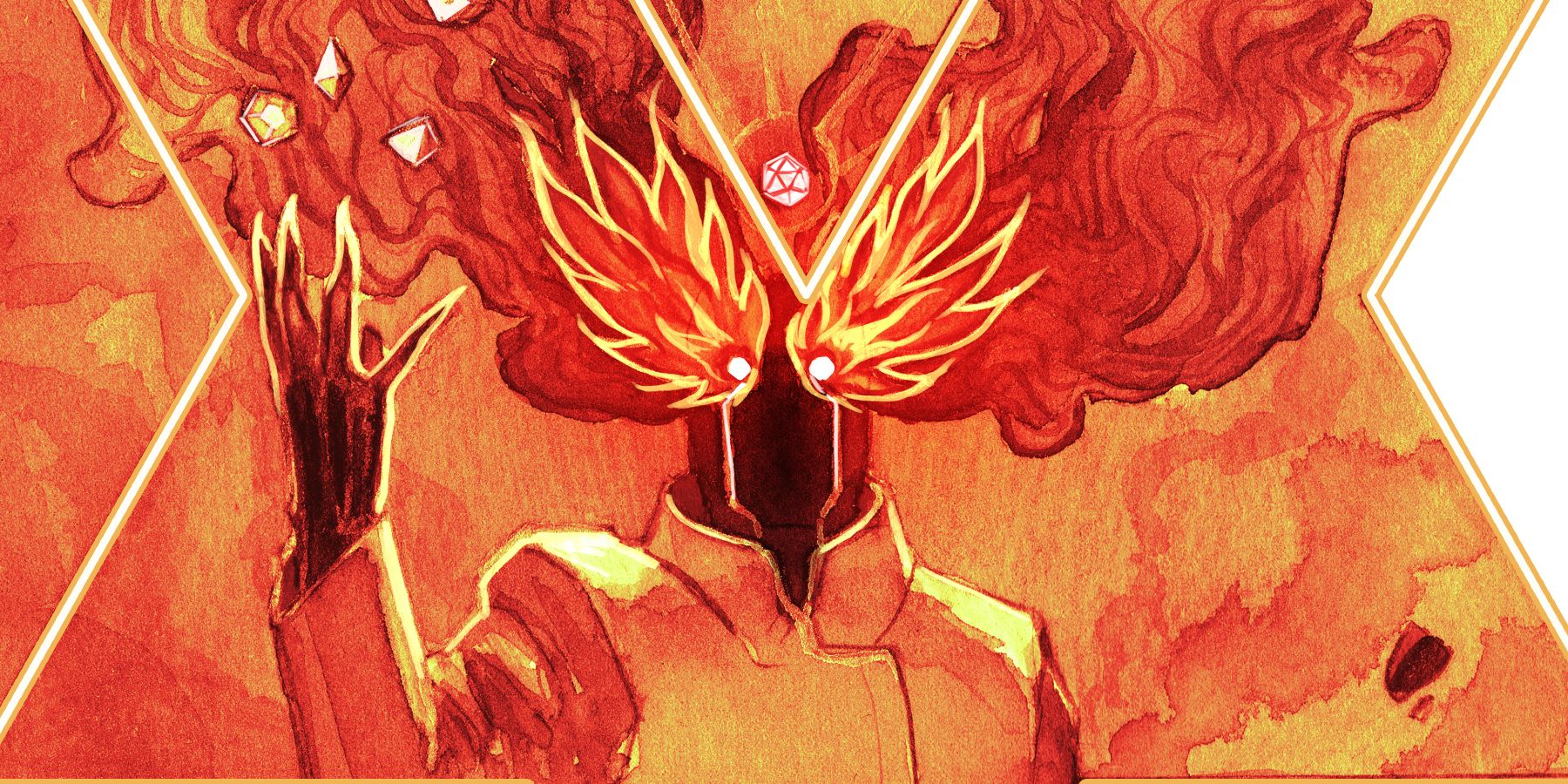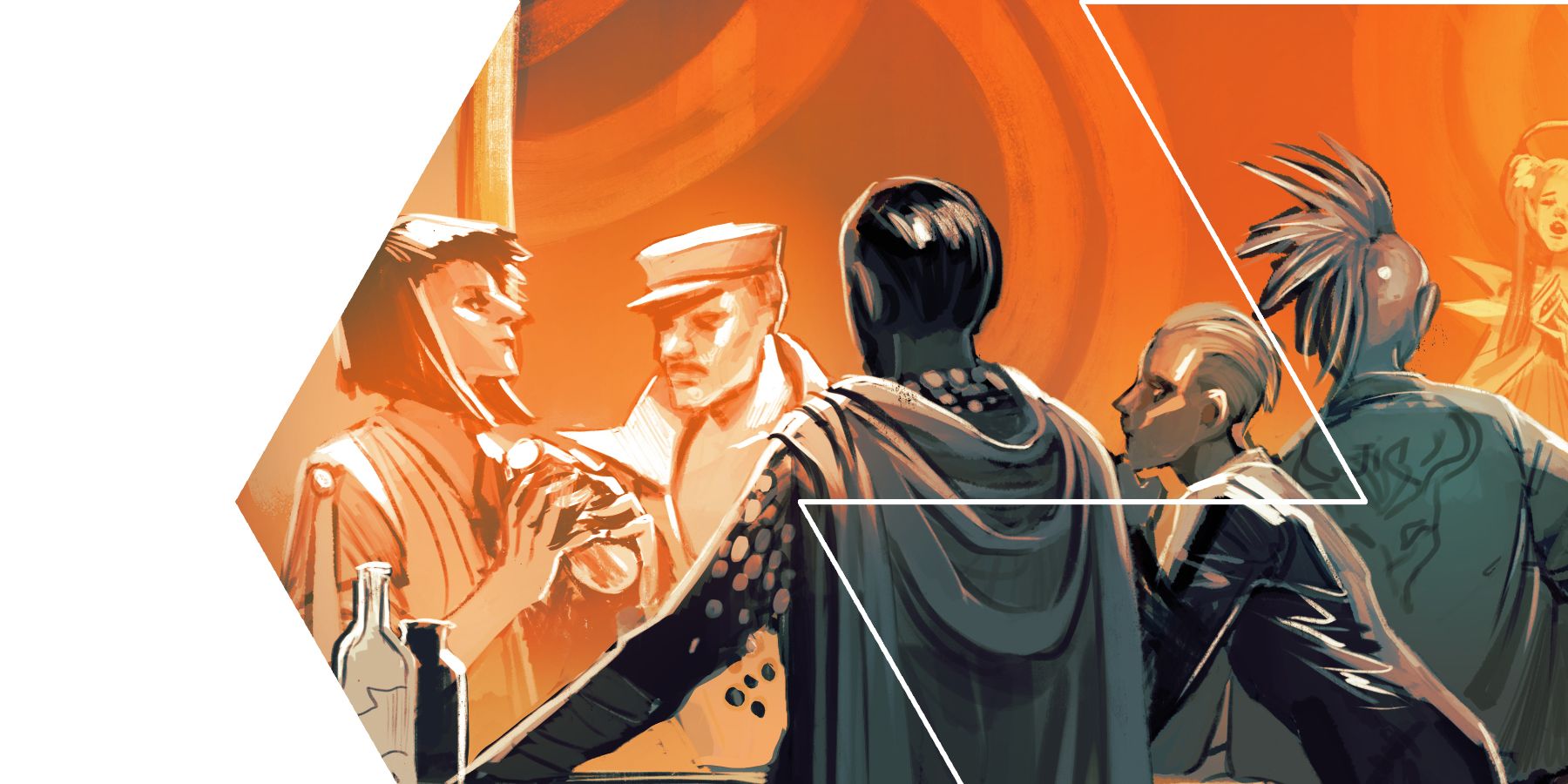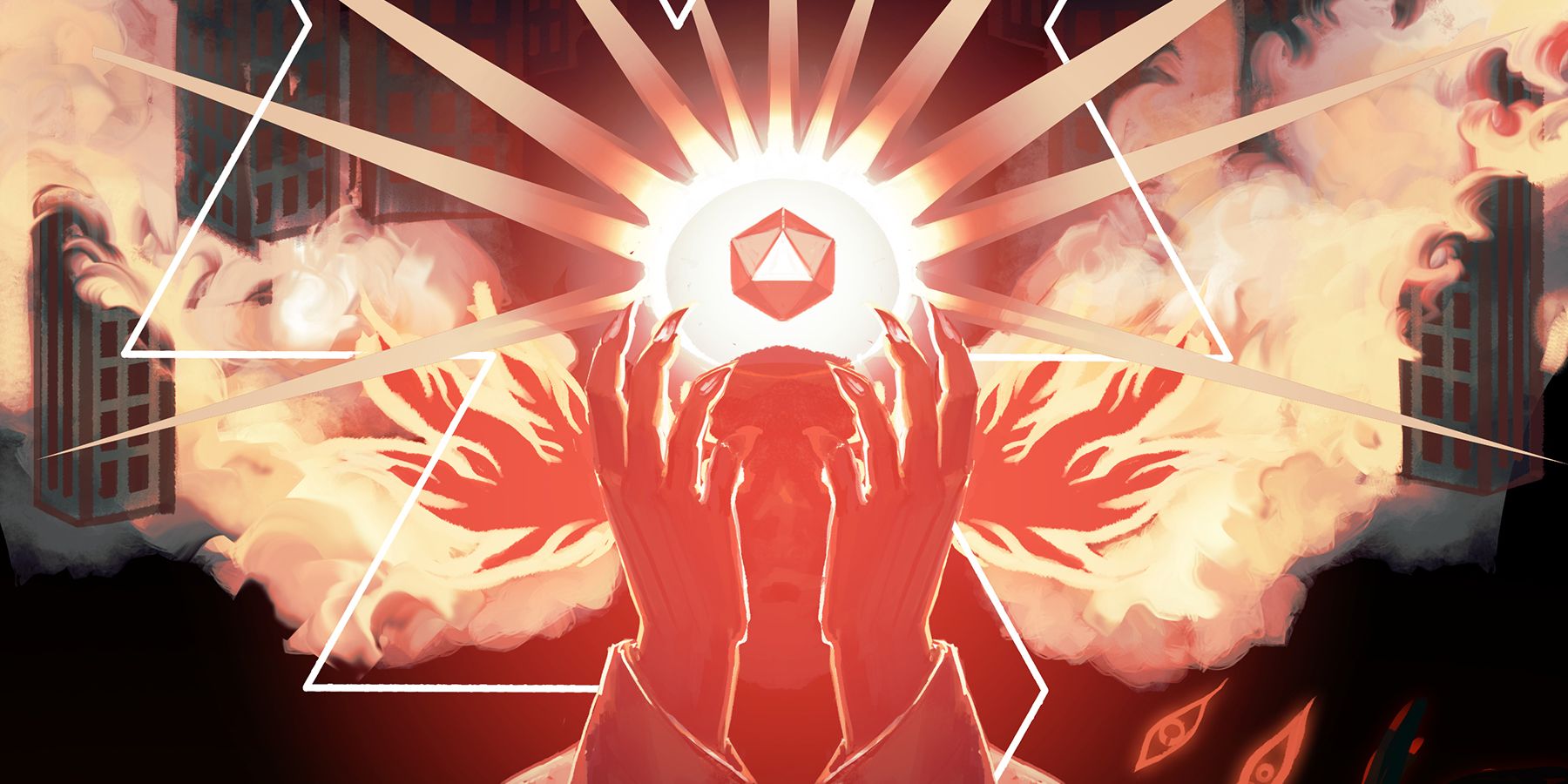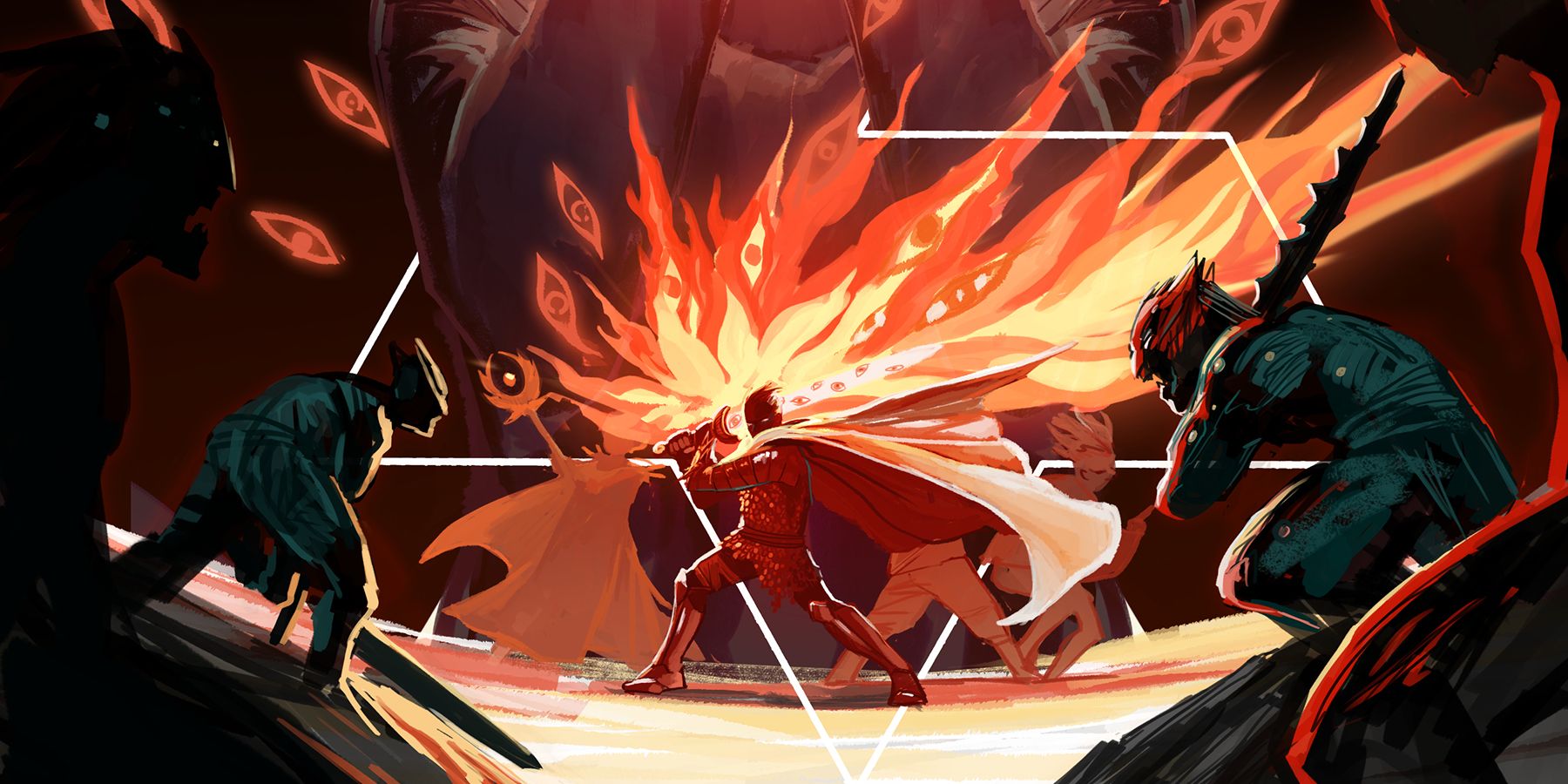Kieron Gillen, author of the award-winning The Wicked + The Divine and Phonogram, teamed up with veteran TTRPG designer Grant Howitt, to adapt DIE into an actual tabletop role-playing system. Gillen's highly metafictional and at-times emotionally devastating comic about role-players trapped in their game world, DIE explores the relationship between reality and fantasy, identity crises, and confronting trauma through fantasy. The forthcoming RPG, currently raising funds on Kickstarter, is structured around the same premise, with players adopting a dual identity of fictional gamers in the real world, who are transported to a harrowing other world.
Gillen and Howitt recently spoke to Game Rant about the game's unique properties, underlying mechanical philosophies, and varied influences. The following interview has been edited for clarity and brevity.
Q: Can you introduce yourselves and share your favorite tabletop RPG class or archetype?
Grant Howitt: I'm Grant Howitt, I'm a role-playing game designer from the UK, and my favorite archetype is the Frontman. So I guess Bard, or Paladin, or Sorcerer, or really anyone with a high enough Charisma score to make my audacious gambits pay off.
Kieron Gillen: I’m Kieron Gillen, and I’m a writer also from the UK, mainly known for my comics work for Marvel and my own books over at Image. I only at this moment realize that I basically am Grant in terms of my classic RPG classes. Anyone with a Charisma score and an urge to talk their way through. Also, the older I get, the more I get to play ethical Paladins, no matter what the system. When I played a character who was basically Parks & Rec’s Leslie Knope meets Red Sonya in Visigoths Vs. Mall Goths, I realized I had a problem.
Q: Describe DIE, for those who are unfamiliar with the comic or the RPG, in a couple sentences.
Howitt: You know the plot of the 80's Dungeons & Dragons cartoon, where a group of kids gets sucked into a mystical otherworld and have to fight to escape? Well - what if that happened, but it was really unpleasant for everyone involved? It's Goth Jumanji. It's Nerd Isekai. It's Alice in Wonderland by way of Eberron. It's high-fantasy trauma exploration with dice.
Q: Kieron, you have mentioned a number of influences on DIE, including Monsterhearts, Paranoia, Warhammer, and of course, Dungeons & Dragons. Can you tell us how those inspirations affected the development of DIE as an RPG?
Gillen: DIE’s a game which, through the filter of a fictional group of people playing an RPG, does kind of ask us “why we play RPGs?” So it’s no surprise that the process of designing is a bit like that for me too—just really looking at what I’ve loved, what I’ve hated and why. There are a lot more influences than the games you list—there’s even a mini-Nordic LARP half-way through character generation—but a lot of it is just part of the whole soil from which my thought grew. Paranoia is both an RPG satire and finds way to do interesting things with a conflicted group. Monsterhearts is all about turning characters’ classes into metaphors. D&D is the ur-RPG, and a lot of DIE is in conversation with it—often trying to re-enchant things which have become familiar.
Sometimes your influences aren’t all good. Early on, I realized what I was doing with combat was actually clearly using some conceptual meat from the ICE’s Middle Earth RP, the cut-down Rolemaster which was my first RPG back in the 1980s. Sometimes, stuff is just in your head… and you have to realize why it’s not right.
Q: What is the general structure of DIE’s mechanics? Will players need to frequently consult tables and calculations, or are the rules more subjective and judgment based?
Howitt: It's a pretty straightforward D6 dice pool mechanic, generally rolling around 2-4 dice, looking for 4+ to succeed and unlocking special stuff on a 6+. I don't believe there's a single table in the book. It's all very freeform, and it has to be, because a lot of the play focuses around the GM mashing up elements from your real-world lives and your fantasy obsessions. So we don't have a rule that says "if the dragon has the face of your abusive boss, you must pass a Will Save or become Distressed for D6 rounds" and instead rely on the GM to apply penalties and bonuses as needed.
Q: DIE has rules for both two-to-four session games and ongoing campaigns. Can you tell us anything about those briefer campaigns? Are they prefixed scenarios like D&D’s Curse of Strahd, more open-ended, or something in between?
Howitt: The briefer campaign is pretty much the core experience of DIE—it gives you enough room to explore your characters and get some development but then wrap things up quickly. We have a few short-form scenarios in the book which offer alternate set-ups for the game, such as the world of DIE being a computer game the group was working on or a comic book which they were all trying to make, too. Now, I've not read Curse of Strahd, but I'm imagining it has quite a lot of maps and NPCs and encounters and things like that, and we don't do things that way. It's all very open-ended to allow you to customize the adventure and have it land with your character group—so rather than providing pre-written material, we offer questions and prompts to guide you towards making something yourself.
Q: Grant, what advice would you give to first-time GMs running DIE?
Howitt: It's not that hard to appear imaginative. All you have to do is put together two things, and suddenly you look like a creative genius. Write down six things your player characters are interested in (or conflicted by) and then mash those together with six fantasy tropes and boom, that's a campaign right there if you're canny about it. Like, say one of the characters is an artist, right? And elves are a fantasy trope, right? So in this world all elves are painted and/or sculpted into being by other elves, and there are artistic movements, and maybe the character can make elves too, and what does that mean? Does their old work come back to haunt them? It's a piece of piss.
Q: Tell us about the early play-testing period. Any amusing stories? How did you address stumbling blocks that alpha and beta players encountered?
Gillen: Oh, this isn’t amusing, except in a “Oh No, That Is A Horror Show If We Get It Wrong” way, is that we ensure everyone addresses each other in a ritual way. In DIE, as you’ve made a real-world human persona, the GM often asks things like “What’s the worst time you’ve ever been hurt?” but they really need to say “Hey, player: What’s the worst time your persona has ever been hurt?” as otherwise everyone’s emotional guts get dragged out and tied into balloon animals.
There are lots of changes. I was playing it as soon as it existed in the rawest form, and every game honed it (and the comic). Weirdly, the core structure of DIE always worked, even in the first games… it was always just a question of trying to get closer and closer to it being as good as it can be.
Q: Can you give us an idea of what combat is like in DIE?
Howitt: Pretty fast and loose! While it forms a lot of the action in the game, it's not a game about combat like D&D is, so it doesn't lean as heavily on tactical options and correct feat choice to make the game interesting. We don't use maps, and you can make up most of the details as you go along, because what's important is that the Grief Knight is exploding with violet energy as they witness the death of their best friend, and they're now strong enough to kick a mountain apart, not where everyone is down to the nearest 5ft square and how far they move in a turn.
Q: What are some of the other core systems covered in the DIE rules?
Howitt: There are not a lot of rules in there! We don't have subsystems really, unless they're specific to the realm that the party is exploring (i.e. swashbuckling Special effects in a pirate themed-world) - everything comes down to that dice-pool, success on a 4+ mechanic. We also talk heavily about the ritual of playing the game itself, and we have a lot of neat stuff in there about making the game feel momentous and special with some pretty easy tricks. And safe, too! We wanted to make sure that a game about exploring trauma, even imaginary trauma, was safe to play.
Q: Grant, DIE’s kickstarter was originally scheduled to launch last October, but was pushed to 2022 due to concerns about material shortages and shipping delays. Can you tell us a bit about the Kickstarter process, and how far in advance you planned the campaign?
Howitt: It's been planned for ages—we just wanted to make sure that everything was in place and we were able to get all the contracts signed and squared away, as well as taking time to finish production on our previous Kickstarters. The world is an unpredictable place right now and a campaign at this scale, if managed poorly, could bankrupt our small business. Thankfully, we have Maz Hamilton on hand to steer us, and we have plenty of contingencies in place both in terms of time and money, and we're confident that—barring unforeseen circumstances, of which there seem to be more than there used to be—we can deliver on time.
Q: Kieron, you developed DIE as a comic and role-playing game concurrently. Can you tell us how the story of the comic shaped the RPG? And, conversely, when you were writing DIE, did you ever change the story to suit the rules of the RPG?
Gillen: “Developed concurrently” is one way of putting it. For a long time, I wasn’t sure which was the tail and which was the dog, and eventually the whole process metabolized, the dog ate its own tail, and we were left with a kind of canine ouroboros of fantasy. Er… I’m going to abandon that metaphor.
The main influence is just that the fact I was doing at least twice as much work that I was thinking about problems twice as much, which gives more depth to both projects. In The Wicked + The Divine, I had a huge playlist, which I listened to a lot for all those years, on shuffle. It was essentially a huge tarot deck, and by constantly re-arranging the elements the songs represented, I thought about it from all sorts of angles.
The game and the comic are like that—a way to really dig into it. I can create the Emotion Knights, who each gain their power by feeling one of eight sacred emotions… but you learn the implications of each of the orders more when you actually have to mechanize them. You realize things like Joy Knights being petrifying, because if they’re happy when they’re fighting, they’re likely ethical monsters, right? Or that Vigilance Knights can use one other general ability to act like a Spider-sense. In short: you really examine the rule.
The big thing which crossed between the two was the Fallen. They existed in my world building, as the standard orc-like monster… but I didn’t realize their awful secret until I was trying to solve the problem of player elimination in DIE. “How about when a player dies, they get back up as a monster.” And I realized that I had a monster called “Fallen” just right there, waiting, perfectly named… and what that implied for every other Fallen you meet.
There are definitely times that DIE feels more like discovery than design.
Q: Kieron, characters in the DIE comic have an interesting duality between their “real” selves and their fantasy selves. How does the RPG play with that dynamic?
Gillen: The characters the persona (real-world people) design speak to who they are, and what they want to be. That’s the core of DIE. And that’s the same for any of us when we sit down to game, right? Maybe we don’t want to be them forever… but we definitely want to step into those shoes for an evening or forty.
So, with DIE, in comic and game, the key thing is that their fantasy selves externalize their true nature (for better or worse). They’re not changing who they are. They’re revealing a part of them they want to explore. It’s not just their own fantasy selves either—the game is always mining the real-world backgrounds of the characters to fold into the fantasy world.
Q: You’ve described the DIE RPG and comic as two different lenses to approach the same sort of core concept. How do you think comic readers and gamers’ experiences will differ?
Gillen: Let’s keep this one basic. The difference is that the game is yours, emerging magically from you and your friends’ creativity. The joys, terrors and answers you get from it will speak entirely to who you are.
Q: DIE is a comic about a fictional game that has a lot to say about real games. How did you capture that metafictional quality in the RPG’s gameplay?
Gillen: I think this core thing was actually the easiest part—it’s just doing what every RPG does, and putting a lampshade on it. We sit down, and play a game which sends us to another world, where we’re another person. That’s every RPG ever. The trick with DIE is making clear that for all the meta-ness which is there in the concept, at the table it’s deeply human experience. In some ways, it’s even more accessible than most RPGs. I’ve no idea what it is like to be an elf, but I’ve met a lot of depressed people who are dissatisfied with their lives and long for an escape. It’s really easy to role-play the latter accurately, right? And the catharsis the persona get on their journey into DIE is very real. It can bounce between being really funny and absolutely tears-on-face poignant in a moment. And, in a roundabout way, having a game which does this is the most important thing that DIE says about games. As in, games are just awesome.
Q: Grant, you have a lot of experience with creating and publishing tabletop games. Do you have any advice for homebrew developers looking to publish their game systems? How do you launch a new tabletop RPG?
Howitt: Get on itch.io and publish whatever crud you've got as soon as you can. Don't worry too much about it being perfect—it won't be! There's no such thing as perfection, just good timing. Build up a library of work. Find out what your style is, what you're about, what ties your games together, and do more of that. People will pay attention if you're not absolutely terrible as long as you have something interesting to say and you're doing it in an unusual way. Then, when it comes time to launch something bigger, you've got an audience, and they can support you and talk about you, and you can go from there.
Oh! And it helps if you're born middle-class and white and male and you're able-bodied and can pass as cishet, all of which apply to me, because that's living life on easy mode when it comes to this industry. I can write whatever I want and no-one gets upset but if one woman writes one supplement about wheelchairs in D&D then suddenly, she's "ruining role-playing games" and a bunch of reactionary choads rock up try to harass her off the internet. Makes me sick.
Q: Kieron, have you ever considered adapting any of your other comics (The Wicked + The Divine, Phonogram) to an RPG format?
Gillen: I have, but I don’t feel the absolute need to make them a game as I did with DIE. Apart from any expansions to DIE, I suspect my next projects will be completely new things. If there ever was a Phonogram or WicDiv or anything else RPG, I suspect they’d be designed by someone else, with me doing any advisory stuff that may be useful.
But never say never, right?
Q: Is there anything else you would like readers to know about DIE?
Howitt: Yeah! It's great! Go back it! You'll have a tremendous time playing it and quite frankly the more the Kickstarter earns the more stable our business becomes and—well, I don't know what Kieron's spending his portion on. Part of a yacht. Diamonds. Luxury horses. That's his prerogative.
[END]
The Kickstarter campaign for DIE: The Roleplaying Game is live until Friday, June 10, 2022.




